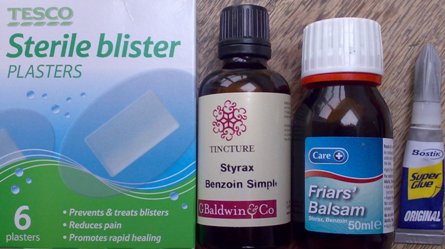
This is the method I concluded from the experiments below:
Disclaimer: doing any of this is at your own risk. If you end up injuring yourself worse or getting a hideous infection, don't blame me...
That will leave you with something that sticks with a vengeance (for some days), taking the place of normal skin. It saw me through VLM 2012 and 2013.
Time for a bit of amateur science...
I'd successfully used a hydrocolloid patch on the same blister a month before for the Cambridge half marathon and it just held out. So I thought I'd try that again -- but I needed the patch to last for 26 miles of hard running this time, not 13. The trouble is that the most determinedly sticky stuff can come loose pretty quickly once the foot starts sweating. And fast running involves higher shear forces on the foot from all those forward pushes, tugging sideways at anything stuck to the skin.
I realised too that it was no good leaving any layers of skin that might still be trapping fluid underneath them. That fluid builds up, and then gets squished sideways on the next run, delaminating the surrounding good skin too. Also things don't stick to it too well. So using surgical spirit, Swiss Army scissors, and a head-torch, I started by removing all of the loosened layers until I got down to terra firma -- but that was pretty raw. (Fortunately I have no photos of that :-)
In fact I went for a two-layer strategy; one piece of blister plaster (just the gooey central bit) trimmed to fit the wound "hole" exactly to bring it up closer to the level of the surrounding skin, and then a second larger layer (but still omitting the non-absorbent surround to the commercial plaster) to smooth over a wider area and add another layer of protection to the central hole.
But how to get those to stay in place for a hard marathon race?
Reading up, I found that other people had used essence of benzoin, othewise known as Friars' Balsam, to help stick blister plasters. It sounded a little bit New Age to me, and I only had a week to get it right. So I put it up against some superglue, and a plaster with no additional help, in a side-by-side test on my hand...
Disclaimer: deliberately sticking things to yourself using superglue is clearly a stupid idea...

The plasters were Tesco own brand because I'd found them better than the Savlon ones I'd also tried. Someone recommended Compeed ones, but it was too late for me to go for something untried. The Friars' Balsam came from expresschemist.co.uk and the essence of benzoin from baldwins.co.uk. I ordered both because I only had days left and was desperate to find a solution, but they seemed to be much the same stuff. Really I should have also tried things like flexible superglue and epoxy resin, but I only decided to run the semi-controlled experiment too late in the day to go shopping.
I would have felt pretty stupid accidentally wrecking a perfectly good bit of my foot in the days before London, so I ran the experiment on my hand instead -- being sure to wash my hands thoroughly, and rub my hands on my bike handlebars through thick sweaty gloves, to give some kind of simulation of the rigours my feet would have to go through.
While tapering in that last week, I used the blister plasters without any special adhesive; then a layer of Vaseline and a fabric plaster on top; then a polythene bag between two socks, for extra slip; and used my comfiest offroad shoes. As I never ran more than about 4 miles in a taper run, that was OK, and let my foot recover a fair bit before the big day.
I stuck the patches on one evening and then took pictures over the next few days to keep track of how each patch had fared. Left to right they are:
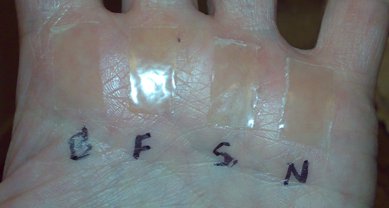 t = 0
t = 0
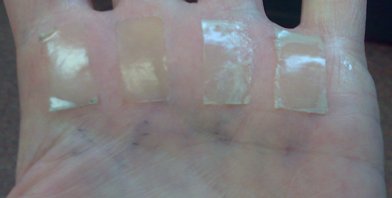 t = 12 hr
t = 12 hr
 t = 16 hr; normal plaster losing it...
t = 16 hr; normal plaster losing it...
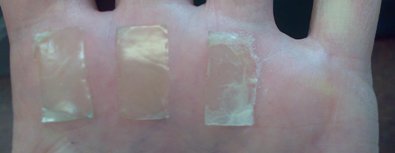 t = 18 hr; normal plaster gone
t = 18 hr; normal plaster gone
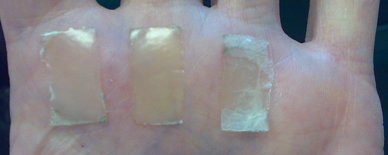 t = 20 hr
t = 20 hr
 t = 23 hr; superglue losing it now
t = 23 hr; superglue losing it now
 t = 24 hr; superglue gone
t = 24 hr; superglue gone
 t = 33 hr
t = 33 hr
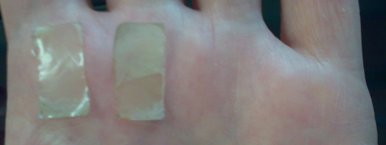 t = 36 hr
t = 36 hr
 t = 37 hr; Friars' Balsam about to go
t = 37 hr; Friars' Balsam about to go
 t = 43 hr; only the essence of benzoin one left now
t = 43 hr; only the essence of benzoin one left now
 t = 57 hr
t = 57 hr
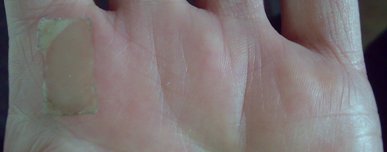 t = 59 hr
t = 59 hr
 t = 60 hr
t = 60 hr
 t = 61 hr; all gone!
t = 61 hr; all gone!
I was a bit troubled by the systematic right to left progression there; if I ran the experiment again, I'd use the reverse order on my other hand to eliminate that possible bias.
But still, I had a clear winner -- so for the London marathon, I stuck my two-layer patches down with liberal amounts of essence of benzoin (and just a cautious smear of Vaseline on top of the smaller patch, to allow some slip between it and the upper patch).
